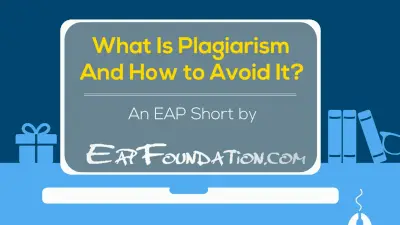Show AWL words on this page.
Show sorted lists of these words.


 







|
 Podcast is loading. Problems? Too slow? You can also access the Podcast by
clicking here.
Podcast is loading. Problems? Too slow? You can also access the Podcast by
clicking here.This message will disappear when then podcast has fully loaded.
Academic writers need to use material from other writers to support their own ideas. Failure to integrate this material appropriately, however, can lead to plagiarism, a form of academic misconduct. This page explains what plagiarism is, gives types of plagiarism, gives some examples of acceptable and unacceptable source use, lists reasons why students plagiarise, and suggests ways to avoid plagiarism. There is also a checklist to help you check your writing for plagiarism.
What is plagiarism?
Plagiarism means using words or ideas of other writers without giving proper acknowledgement - that is, without making it clear that the words or ideas are not your own, or without making it clear whose they are. Plagiarism is a widespread problem in higher education, and most universities use plagiarism detection tools such as Turnitin to tackle plagiarism issues. Historically, plagiarism has been viewed as an academic crime, which is evident from the collocation commit plagiarism; other collocations with this verb are commit murder and commit a crime. However, since much plagiarism is unintentional, the term textual borrowing is often used in place of the word plagiarism to remove the negative connotations.
Types of plagiarism
Plagiarism can be categorised according to the intent of the writer into intentional plagiarism (also called deliberate or prototypical plagiarism) and unintentional plagiarism (also referred to as textual or accidental plagiarism). While the intent of the writer can be difficult to determine, there are various common indicators that the plagiarism is unintentional and results from a lack of understanding of academic conventions. These include attempts to cite sources, either directly in the text or via a reference section, as well as attempts to paraphrase the source material, however poorly.
It is also considered unacceptable to copy from your own earlier work. Such plagiarism is called self-plagiarism, and incurs the same penalties as plagiarising from another writer.
Examples of acceptable and unacceptable source use
The following gives examples of unacceptable source use, i.e. plagiarism. The original source is shown first, followed by two plagiarised examples.
ORIGINAL TEXT (Source: Pears and Shields, 2013)
Paraphrase: A restating of someone else's thoughts or ideas in your own words.
PLAGIARISED TEXT #1 - copied, no in-text citation
Paraphrase means restating of someone else's thoughts or ideas in your own words.
PLAGIARISED TEXT #2 - copied
According to Pears and Shields (2013), paraphrase means restating of someone else's thoughts or ideas in your own words.
In the first example, neither in-text citation nor paraphrase has been used. In the second example, although an in-text citation is used, the text has been copied word-for-word without paraphrasing, which is plagiarism.
The following shows two ways this material could be incorporated in an acceptable manner into the writer's text. The first example uses quotation, while the second uses paraphrase.
ACCEPTABLE TEXT #1 - using in-text citation + quotation marks
According to Pears and Shields (2013), paraphrase means "restating of someone else's thoughts or ideas in your own words".
ACCEPTABLE TEXT #2 - using in-text citation + using paraphrase
According to Pears and Shields (2013), paraphrase is a restatement of another person's ideas or thoughts using your own words.
Why do students plagiarise?
Students plagiarise for many reasons, which vary according to the type of plagiarism being committed.
Intentional plagiarism - reasons
Intentional plagiarism can result from a desire to gain an advantage, a belief that the plagiarism will not be detected, or a lack of confidence by the student in their own writing ability. Time difficulties, mentioned in more detail below, can also lead to intentional plagiarism, as a student may deliberately copy in order to save time. The ease with which information can be accessed from the Internet can also make it tempting for students to copy and paste directly into their assignment.
Unintentional plagiarism - reasons
Unintentional plagiarism is likewise caused by a variety of reasons. One of these is a lack of understanding of what plagiarism is and that uncited copying is not acceptable. This is especially the case for students whose first language is not English. In some cultures, for example Confucian Heritage Cultures, uncited copying is not only acceptable but expected.
A second reason why students commit unintentional plagiarism is time difficulties. These can be the result of having to complete several assignments over a short period of time, or caused by poor time management. Time difficulties can lead to unintentional plagiarism since the student may lack time to paraphrase sufficiently, or may lose track of which information is from which source or which material is their own.
A third reason is lack of citation skills. In-text citations are used to acknowledge who wrote the original ideas, and if these are missing, or there are too few of them, then ideas from others writers will not be properly acknowledged.
A fourth reason is an inability to paraphrase appropriately. Beginning academic writers may make only surface-level changes, e.g. changing some words using synonyms. The term patchwriting (Howard, 1993) is often used to describe this kind of paraphrasing, which results in a text which matches the original too closely. Patchwriting is seen as an important stage for developing writers, and this type of plagiarism should be seen as a learning opportunity.
A final reason why students plagiarise unintentionally is because of a lack of good note-taking skills. Students may fail to take notes using their own words, and therefore unintentionally copy from the original when using their notes.
In short, reasons why students plagiarise include:
- a desire to gain an advantage [intentional];
- a belief that the plagiarism will not be detected [intentional];
- a lack of confidence by the student in their own writing ability [intentional];
- ease of access to sources on the Internet [intentional];
- lack of understanding of what plagiarism is [unintentional];
- time difficulties [intentional and unintentional];
- lack of citation skills [unintentional];
- inability to paraphrase appropriately [unintentional];
- lack of good note-taking skills [unintentional].
Avoiding plagiarism
Methods to avoid plagiarism relate to the reasons why students plagiarise, given above. It is important for students to have a clear understanding of what plagiarism is and its consequences. This, along with training in citation skills and paraphrasing skills, is a core component of any academic English writing course. Contrasting academic conventions in English and in the student's own language may be helpful.
Improving time management skills will help students avoid time issues that might lead to plagiarism. Students can be advised to ask tutors for an extension if they feel particularly overloaded, which some tutors may be willing to grant.
Familiarisation with appropriate citation requirements is important. There are many different systems that are commonly used, e.g. Harvard, APA, and MLA. Different universities, and different departments within the same university, will use different systems, so students will need to be clear what the conventions are for their course.
Learning how to take effective notes will also help students avoid plagiarism. Students should take notes in their own words. If any words are directly copied from the original text into notes, quotation marks should be used so that these quotations are not accidentally transferred into the final text. It is also important for students to use their own notes, and not borrow someone else's, since they will not know whether the notes are in the student's own words - in addition to which, copying from another student's notes is also a form of plagiarism.
If students have access to an anti-plagiarism tool such as Turnitin, they may be able to submit a draft assignment to check for plagiarism, before submitting the final assignment. Such software will only identify plagiarism due to inadequate paraphrasing, rather than lack of citations. Students should check with their tutor to confirm whether multiple submission of assignments like this is possible.
Finally, Internet sources should be avoided, if at all possible. Most university courses will expect students to cite from academic articles or text books rather than Internet sources. If Internet sources are used, it is important for students to take notes, as with any source, rather than copy and paste directly into their writing. A common error is to copy and paste first and paraphrase later, though it is all too easy to lose track of which words are from source material, and which source they are from.
References
Ali, W.Z.W., Ismail H. and Cheat, T.T. (2011) 'Plagiarism: to what extent it is understood?', UKM Teaching and Learning Congress 2011. Available from: http://dx.doi.org/10.1016/j.sbspro.2012.09.320.
Howard, R.M. (1993) 'A plagiarism pentimento', Journal of Teaching Writing, 11(3), pp.233-246.
Stapleton, P. (2011) 'Gauging the effectiveness of anti-plagiarism software: An empirical study of second language graduate writers', Journal of English for Academic Purposes 11 (2012), pp.125–133. Available from http://dx.doi.org/10.1016/j.jeap.2011.10.003.
Sun, Y. (2013) 'Do journal authors plagiarize? Using plagiarism detection software to uncover matching text across disciplines', Journal of English for Academic Purposes 12 (2013), pp.264–272. Available from http://dx.doi.org/10.1016/j.jeap.2013.07.002.
Sun, Y. and Yang, F. (2015) 'Uncovering published authors' text-borrowing practices: Paraphrasing strategies, sources, and self-plagiarism', Journal of English for Academic Purposes 20 (2015). Available from http://dx.doi.org/10.1016/j.jeap.2015.05.003.
Checklist
Below is a checklist for avoiding plagiarism. Use it to check your writing if it includes reference to external sources, or ask a peer to help.
| Area | Item | OK? | Comment |
| Citing sources | The text includes in-text citations. | ||
| The in-text citations are in the correct format, e.g. surname(s) + year for Harvard style referencing. | |||
| In-text citations are given each time an external source is used in the text. | |||
| It is clear which ideas are the writer's, and which are from external sources. | |||
| Paraphrasing sources | Original texts have been changed in several ways (changed words, changed word forms, changed word order) to make the paraphrase acceptable. | ||
| If direct quotation is used instead of paraphrase, quotation marks " " have been used to signal the quotation. | |||
| If possible, the text has been submitted to an anti-plagiarism checker such as Turnitin to ensure there are no instances of plagiarism from poor paraphrasing. |






